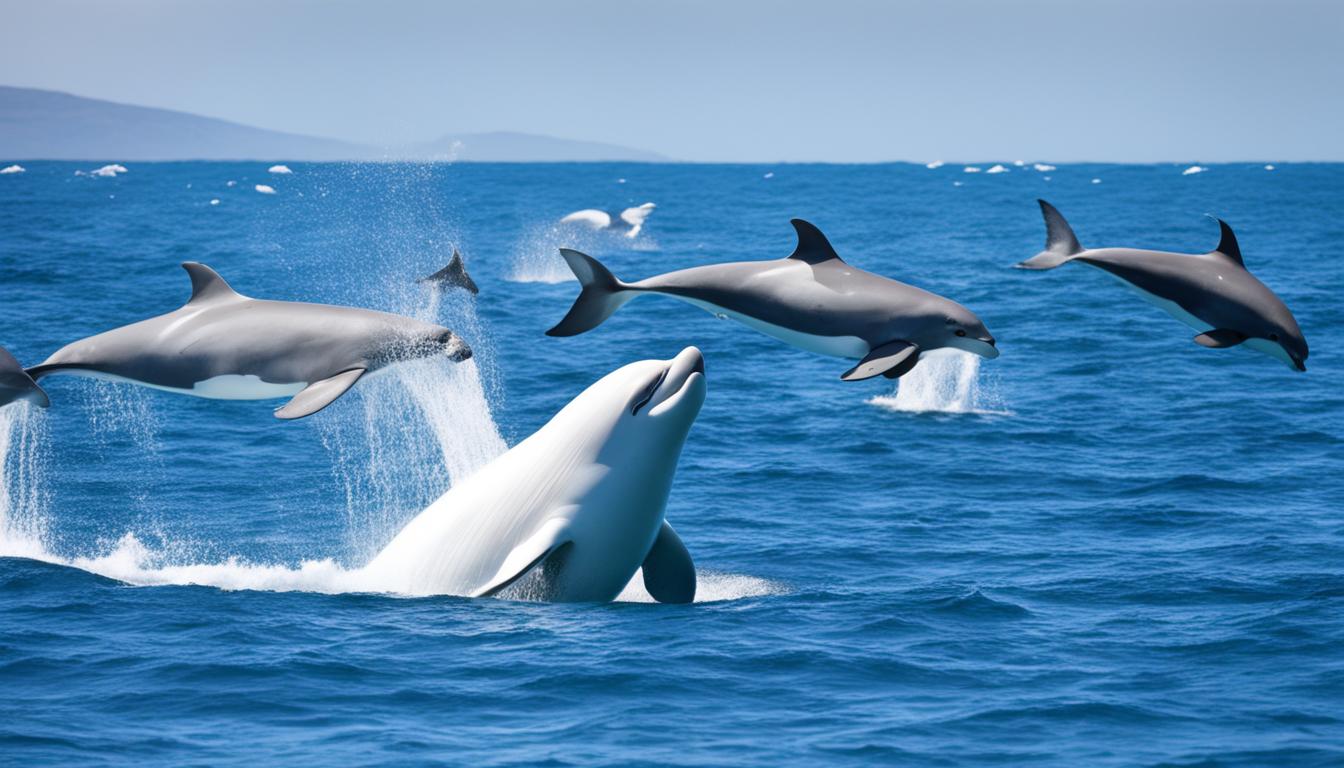Beluga whales, known scientifically as Delphinapterus leucas, have complex interactions with many species. These interactions show their key role in marine ecosystems. They live in groups that are very social and work together.
Belugas communicate and hunt together, showing how they connect with their group and other sea creatures. This shows the deep relationships they have with other marine life. Knowing about these interactions helps us understand their importance in the ocean.
Understanding Beluga Whale Social Behavior
Beluga whales live in groups called pods, which are key to their survival and communication. These creatures show complex social behaviors. Their social structures are vital for their daily life and happiness.
Group Dynamics and Pod Structure
Beluga pods usually have 2 to 25 whales, but can grow to 200 to 10,000 during migrations. In these groups, males often lead, while females take care of the young. This shows the strong social bonds within these communities.
Social Interactions within Pods
Belugas value friendship and teamwork. They play and rub against each other to strengthen their bonds. They also help young whales, showing their caring side. Their way of talking to each other helps keep their group close.
| Pod Size | Typical Members | Formed During Migration |
|---|---|---|
| 2 – 25 | Average: 10 | 200 – 10,000 |
These behaviors show how smart and social beluga whales are. Watching them helps us understand their complex social lives.
How do beluga whales interact with other marine life?
Beluga whales have interesting marine life relationships with many species in their home. These relationships are key to keeping the ecosystem balanced. They show how beluga whale ecosystem interactions work together.
Belugas often travel with narwhals and bowhead whales in big groups. This helps them stay safe from predators and find food together. It’s a great example of how they work together and adapt in the water.
They don’t just hang out with other animals. Belugas play with dolphins and sea lions, which helps them learn and connect. These activities are important for their social life within their groups.
The following table shows different ways beluga whale interactions happen with other sea creatures:
| Marine Species | Type of Interaction | Purpose |
|---|---|---|
| Narwhals | Migration companionship | Safety in numbers |
| Bowhead whales | Shared feeding areas | Food availability |
| Dolphins | Playful social interactions | Social bonding |
| Sea lions | Curiosity-driven encounters | Learning behavior |

Learning about these creatures and how they live together deepens our understanding of the ocean. Seeing how beluga whales interact shows their social side. It also highlights the need for healthy oceans for all living things.
Beluga Whale Communication with Marine Animals
Beluga whales are amazing creatures with top-notch communication skills. They use a variety of sounds to talk to each other and their surroundings. This shows how smart and flexible they are in the underwater world.
Vocalizations and Echolocation
Belugas make many sounds like clicks, whistles, chirps, and grunts. These sounds help them navigate, talk to friends, and hunt. They also use echolocation to get info about their world.
Their special melon in their heads helps make and send sounds. These sounds hit objects in the water and come back, telling the whales about their distance and shape.
Curiosity Towards Other Species
Beluga whales are very curious about other sea creatures. They like to check out new animals and sometimes even go near boats. This shows they’re playful and really connect with the sea and its life.
This curiosity makes their world more interesting. It helps them build complex relationships with other sea animals.
Beluga Whale Ecosystem Relationships
Beluga whales play a key role in their ecosystems. They have complex relationships with other marine life. These relationships are crucial for keeping the ocean healthy.
Predator-Prey Interactions
Beluga whales are at the top of their food chain. They eat fish like herring, capelin, and salmon. By eating sick or injured fish, they help keep fish populations in check.
This helps the fish and the whole ocean stay healthy. It shows how belugas keep the balance in nature.
These predator-prey interactions are important for biodiversity. Belugas help stronger fish survive and grow. This affects the whole food web, showing how belugas connect with other species.
Symbiotic Relationships with Other Marine Life
Besides being predators, belugas have symbiotic relationships in marine life. These relationships help both the whales and other sea creatures. For example, some fish clean parasites off belugas. In return, they get food and safety from predators.
This teamwork is key to a healthy ocean. Every species, including belugas, plays a part in keeping the sea balanced. Knowing about these relationships helps us value belugas more.
| Interaction Type | Description | Examples |
|---|---|---|
| Predator-Prey | Regulation of fish populations by hunting | Herring, capelin, salmon |
| Symbiotic | Mutual benefits between belugas and cleaning species | Cleaner fish |
| Ecological Balance | Maintaining a healthy marine ecosystem | Impact on biodiversity |
Beluga Whale Cooperative Hunting Strategies
Beluga whales are amazing at hunting together. They form groups called pods to catch food. They work together to herd fish into tight groups, making it easier for everyone to eat. This shows how important teamwork is for them.
They use echolocation to find food. By sending out clicks and listening for the echoes, they can spot prey under the water. This skill helps them hunt even in murky or icy waters. It shows how smart they are at finding food.
Studies reveal that working together helps them catch more food. This teamwork also strengthens their social ties. As they achieve their goals together, their relationships within the pod get stronger. This makes their social groups more united.










